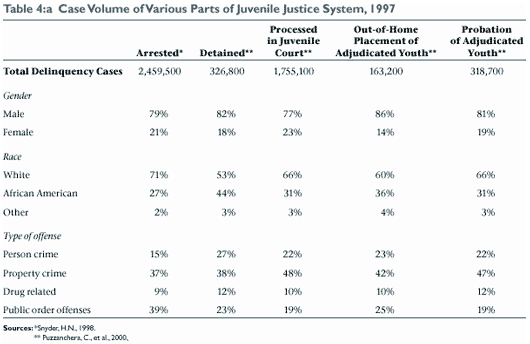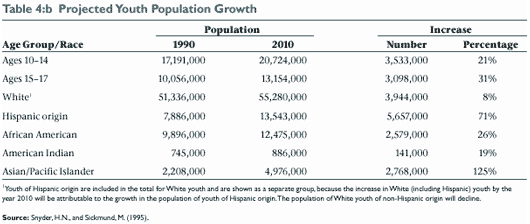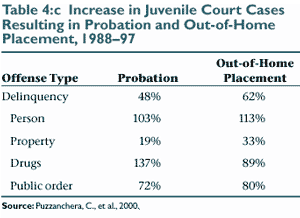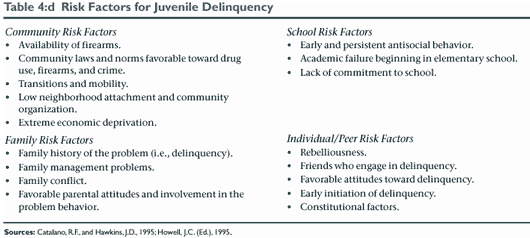Chapter 4: Planning and Forecasting for Juvenile Corrections
Key Elements of Forecasting and Planning
While forecasting and planning are two different processes, they are very interrelated. Without engaging in some forecasting activities, planning may veer far from the best course for solving a particular problem or addressing an issue or condition in juvenile corrections.
Forecasting
Forecasting means predicting something that will happen in the future or estimating the probability that it will happen. Predicting weather conditions is a common application of forecasting. Meteorologists link their past experiences with weather conditions and scientific information about weather patterns to predict what the weather will be like in the future. Weather forecasts often are correct; and of course, they frequently are mistaken, either in terms of the intensity or timing of weather conditions. Weather forecasts are used to plan activities, such as when to go on a picnic, when to mow the lawn, or what clothing to wear on a particular day. Sometimes forecasts are wrong and the picnic gets rained out, the lawn gets too dry, or the outfit selected is too cool for the colder-than-expected temperatures.
People use forecasting and planning in many other aspects of their personal and professional lives:
- They forecast that their jobs are secure and their income will be sufficient to purchase a house.
- They estimate that they can complete a task at work within a given amount of time and, therefore, can also accept responsibility for an additional assignment.
- They think it is likely that a business meeting will be long, and they forego dinner plans.
- They predict that additional training and education will make them more marketable and, therefore, invest in education.
Forecasts often miss the mark of 100 percent accuracy. However, they provide the best basis for planning available. Considering many variables is vital when developing forecasts. The social, economic, and political contexts always must be considered when forecasts are used. For example, in a largely industrial setting, one must consider the possible effects if a major manufacturer were to close operations. Employment and economic conditions in a community or State could change drastically. Many prognosticators believe changes in welfare will increase the Nation's population of poor children, at least temporarily. Political tides and public opinions often vacillate between liberal and conservative viewpoints, and these changes frequently prescribe different responses to delinquency. Some of these consequences are reasonably predictable, while others are unexpected and probably cannot be incorporated in jurisdictional or program forecasts and plans. Neither can the actions of particular individuals necessarily be predicted. For example, a judge who believes only youth who commit a second violent offense should spend some time in confinement, or a probation officer who takes youth back to court for any and all violations of conditions of probation will both affect related juvenile corrections programs.
Forecasting in juvenile corrections is far from an exact science. However, there are data, including case volume, trends, and research on causes and correlates of delinquency, that help establish probabilities for future needs and directions to be taken.
Case Volume. For several years the Office for Juvenile Justice and Delinquency Prevention (OJJDP) has been collecting and analyzing data on juvenile offenders. From this information, much can be learned. Table 4:a provides a summary of 1997 data on juvenile cases in which juveniles were arrested, detained, processed through juvenile court, placed out of their homes, and placed on probation.

Trends. Forecasting involves looking in both directions: to the past to understand tendencies and to the future to make predictions. Knowing the general population trends helps predict future needs. Demographers can predict with suitable accuracy (barring some unforeseen calamity or major reversal in trends) the size of the juvenile population for the next 20-30 years. Considering just youth between 10 and 18 years of age, Table 4:b predicts the increase in the general population and among youth from various racial groups by the year 2010.

The data in Table 4:b advise juvenile justice professionals that during the next decade and beyond, the number of youth who potentially may commit delinquent acts, and thus be inducted into the juvenile justice system, will increase. These data provide some important indicators about what may happen in juvenile corrections by the year 2010 based on past trends:
- Older youth tend to commit crimes and be arrested, referred to court, and placed in juvenile corrections programs more than younger ones. As the 15- to 17-year-old age group is expected to grow more than the younger group, the size of the delinquency population will be likely to increase accordingly.
- Currently, African American youth and youth of Hispanic origin are disproportionately represented in the juvenile justice system. These two groups are predicted to expand significantly. Therefore, if trends continue in combination with the growth in these two groups, the impact on juvenile corrections will be compounded.
- In addition, the female juvenile justice population has been increasing at a faster rate than the male juvenile justice population. If this trend persists, girls may continue to claim larger portions of corrections resources.

From this table, if trends continue, juvenile corrections professionals are likely to see the following differences in their populations in the future:
- Greatest increase in youth placed in community corrections.
- Significant increases in youth who have committed person offenses.
- Marked increases in youth placed out of their homes for drug-related offenses.
- Decreasing numbers of youth placed out of their homes for status offenses.
Causes and Correlates of Delinquency. Research has identified the risk factors associated with juvenile delinquency, substance abuse, teenage pregnancy, dropping out of school, and violence. For the purposes of this chapter, only those risks correlated with delinquency will be considered; however, all areas are, of course, interrelated (Catalano and Hawkins, 1995; Howell, 1995). Table 4:d summarizes the risk factors for juvenile delinquency.

Several trends are closely associated with risk factors for juvenile delinquency (Snyder and Sickmund, 1995):
- Juvenile offenders disproportionately are of lower socioeconomic status, and trends indicate this population is increasing.
- Families with children are more likely to live in poverty.
- Between 1972 and 1992, poverty rates for children under age 18 increased from 16 percent to 22 percent.
- Between 1976 and 1992, the number of juveniles living in poverty grew 42 percent.
- Children under age 18 represented 40 percent of all people living in poverty in 1992.
- Minority juveniles experienced the highest levels of poverty—47 percent of African American youth, 40 percent of youth of Hispanic origin, and only 17 percent of White youth lived in poverty in 1992.
- Families with children are more likely to live in poverty.
- Juveniles today are more likely than in the past to live in families without both parents present, and children living in single-parent homes are more likely to be poor.
- Forty-six percent of children in single-parent homes in 1989 lived in poverty.
- One out of 20 births was to a single mother in 1960, but by 1990, 1 out of 4 births was to a single mother.
- Between 1960 and 1990, the number of divorces nearly tripled.
- Only 73 percent of children lived in two-parent families in 1990, compared with 85 percent in 1970.
- About half of children born between 1970
and 1990 will spend some time living in a
single-parent family, and single-parent families are more likely to live in poverty.
- Forty-six percent of children in single-parent homes in 1989 lived in poverty.
- Five percent of births in 1991 were to mothers under 18 years of age.
- Between 1980 and 1991, the rate of births to unmarried women between the ages of 15 and 17 increased by 50 percent.
- Minority youth are overrepresented among the juvenile corrections population, and they are the fastest growing segment of the youth population.
- Youth not attending school and not working are at an increased risk for engaging in crime.
- Youth from low-income families were most likely to drop out of school in 1992.
- Hispanic youth are more likely to drop out of school than either African American or White youth.
- Between 1935 and 1990, the percentage of youth between 16 and 19 years of age who were neither working nor attending school declined slightly (from 5.3 percent to 5 percent).
- Youth from low-income families were most likely to drop out of school in 1992.
Planning
"[P]lanning involves the orderly, systemic and continuous process of anticipating future events and using those prognostications for current decision making" (Steenson and Thomas 1997:35). Steenson and Thomas (1997) go on to list the ways planning benefits organizations, including:
- Preparing for unchangeable events and conditions that will occur in the future.
- Making proactive changes in areas that can be modified to benefit the organization.
- Changing and enhancing the organization.
- Maintaining and strengthening stability in the organization.
- Solving pivotal issues the organization encounters.
- Operational planning for near-term, functional problems or conditions that are relatively narrow in scope.
- Strategic planning for long-term direction of the organization around broader issues.
This chapter examines both of these planning approaches as they apply to juvenile corrections.
Operational Planning. Operational planning is used to resolve immediate problems or develop new ways of responding to particular needs or situations. This type of planning is characterized by short timeframes between the planning process and the implementation of the change. It generally is limited to addressing a single problem, issue, or condition.
Change occurs continually. Even with the best forecasting and long-range planning, it is impossible to address every potential change that will occur. Alterations or improvements also may be needed in day-to-day operations that are not addressed in strategic planning. Planning a new project or service, adjusting budgets, changing personnel policies, and improving public relations are examples of operational planning. Usually, the results of these planning activities lead to immediate modifications in some aspect of the organization, but they will not necessarily change the overall mission, goals, and activities of the agency or program.
Operational planning should involve those who will be affected by it, but it may not be necessary to include all organizational stakeholders in the process. For example, assume the Johnson City Probation Department now has regular operating hours from 8:00 a.m. until 5:00 p.m., Monday through Friday. However, the agency wants to ensure that more Probation Officers are available at times when youth are out of school (e.g., afternoons, evenings, and weekends). Line officers, managers, and administrators might form a task group to plan for this change. In doing so, they may have to consider various scheduling patterns for both line officers and supervisors, work time reporting and verification, officer safety issues and backup, use of agency vehicles, caseload distribution, and evaluation of the plan to determine if it is more effective for working with youth. When the task group has reached agreement on its recommendations, the recommendations are presented to the Chief Probation Officer. If he or she approves the changes, they are implemented as soon as feasible.
Operational planning may occur at any time a problem, condition, or issue is identified and there is sufficient agreement that change is needed. This is not always easy, as some members of the organization may see a need for a change while others do not. Some members may have a vested interest in maintaining the status quo. For example, in the Johnson City situation, it may be more difficult to begin the planning process if some of the Probation Officers are single mothers with school-age children, and they prefer to be home in the evenings. These Officers might need to maintain the 8-to-5 work schedule, even though they may agree that it would be ideal to have more staff accessible in the evenings. Sometimes, resistance to change may come from managers or administrators and might involve an array of motives, such as monetary issues, power and control, and ideological differences.
Operational planning is needed and used throughout juvenile corrections. Detention, probation, residential facilities, and aftercare programs all will encounter problems and conditions that need to be addressed in the near term. For example, a detention program may modify security, a residential facility may enhance its educational program, and an aftercare program may start a relapse prevention program. For any of these changes, success is likely to be enhanced by following a systematic planning process that will be discussed later.
A special type of operational planning is specific to projects that are time limited. These may include projects undertaken with grants or other time-limited funding or projects developed in response to a special need that will not be ongoing. In these cases, planning also needs to include what will occur when the project ends. How will the organization function following the project?
Strategic Planning. Strategic planning is used to assess organizational values, mission, and goals and to develop the direction the agency will take over a long period. Strategic planning usually looks 5 or more years ahead. Implementation of changes typically are phased in over the life of the plan.
Based on the work of Hudzik (1996), Steenson and Thomas (1997:35) write:
The purpose of strategic planning is to determine and reveal organizational purpose through long-term objectives, action programs, and resource allocation priorities. Strategic planning allows organizations to achieve long-term sustainable advantages by responding properly to the opportunities and threats posed by the environment and the organization's strengths and weaknesses.
In a relatively short span, significant changes in the youth population and delinquency patterns have affected juvenile corrections, as illustrated in the previous section on forecasting. Programs continually need to examine their operations in light of such changes. Many programs have not done a very good job of keeping abreast of changing needs; a program developed in the 1960's is unlikely to be able to meet current needs with the same mission and goals. Many detention and residential programs experience crowded conditions because of the growth in the juvenile population, for which they were unprepared. Strategic planning must consider options for additional bed space and/or ways to reduce the population. For example, a jurisdiction might decide to intensify prevention programming to avert youth from committing delinquent acts and entering the juvenile justice system. On the other hand, a detention center might consider the possibility of phasing in in-home detention or electronic monitoring programs for youth who meet certain criteria to reduce the in-house population.
Steenson and Thomas (1997:36) identify four essential characteristics of the evolutionary character of strategic planning:
- It facilitates change by creating the appropriate conditions for seeking individual and organizational excellence.
- It encourages collaboration by emphasizing compatibility and consensus in decisionmaking.
- It is belief driven and relies on the identification and articulation of mutual beliefs within the organization.
- It is long term and holistic.
| Jurisdictional Technical Assistance Package for Juvenile Corrections | Report - December 2000 |